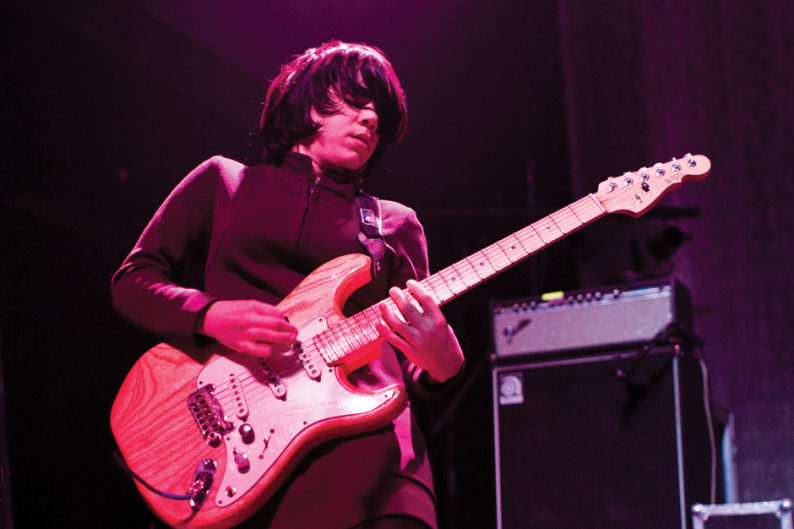I used to see this peacock that would play guitar outside of Blue Jays games. This was in Toronto when I was 13 or 14, so the mid-’90s. I’d be walking with my dad and brother to the stadium, and on one of the causeways there’d be a dude — his hair flowing and feathery, his feet spread wide in the classic power-rock stance, amp between his legs — fucking wailing for loose change. Wheedly wheedle wee and deedly deedle dee. Even then, to a kid, this guy seemed clearly past it — a Ripping Van Winkle who’d slept through the changes that had relegated his flamboyantly dressed, technically excessive brethren (a lineage that begins with Deep Purple’s imperious Ritchie Blackmore, crests at Eddie Van Halen, and reaches its frilly extreme with neo-classical Swedish virtuoso Yngwie Malmsteen) into the cheese bin of history.
Show-offs. Relics. Wankers.
But shred’s not dead. It only needed to change clothes, to swap spandex for ratty jeans. Unencumbered by lingering connotations of vanity or self-indulgence, a diverse and talented group of young-punk six-stringers (see next page) has provided a perfect case study for the ways in which context and character can reclaim a once-derided element of rock. And, of course, singe some short-and-curlies in the doing.
“There’s no room in music for trite garbage,” says Screaming Females frontwoman Marissa Paternoster, 24, whose band’s fierce new album Ugly, released in April, is the opposite of that description, and who plays precise, lightning-strike guitar. “It’s boring to get up there like you’re in Chickenfoot and shred over Cabo Wabo rock. But it’s not lame to want to master your instrument. Some people might think having a certain amount of instrumental skill is self-indulgent. But I could give a fuck about that.”
Paternoster’s ungiven fuck underlies the attitude of this new breed of guitar hero. If the Malmsteen model — flashy persona, flashier playing — seemed intent on producing music designed to garner awe and oral sex, this new approach, humbler and less pretentious, sees the smoking solo as a spiritually subtler provocation.
“I’ve heard people straight-up say they don’t like guitar soloing, then be surprised by how exciting it is,” says Paul Saulnier, 29, of yelping Ontario punk duo PS I Love You. The band’s upcoming album, Death Dreams, set for a May release, is dense with Saulnier’s strafing, finger-tapped leads.
“A lot of listeners who have come of age in the last ten years didn’t experience the excess of ’80s guitar-playing firsthand,” he continues. “They’ve just been trained by ‘indie’ thinking that solos are self-indulgent. But they’ve never really been exposed — soloing pretty much disappeared after grunge. Once people listen, they can tell I’m not trying to hot dog,” he insists. “I’m just trying to play with passion.”
The disappearance to which Saulnier refers, hastened by the anti-hero ethos of the ’90s, is closely linked to a fragmentation that’s allowed the fiery guitar solo (as distinguished from the amiably drifting improvisations of jam-band pickers) to re-emerge on rock’s margins.
“Because of how wide-ranging rock is now, there’s no cohesion about who the enemy is,” argues David Todd, author of the new book, Feeding Back: Conversations With Alternative Guitarists From Proto-Punk to Post-Rock. “There aren’t these monolithic dinosaur-rock figures, like Eddie Van Halen or hair-metal players, for young musicians to react against.” The result, says Todd, “is that you can do whatever you want. Every style of playing is available. That includes playing fast hard-rock guitar solos.”
Put another way, the paradigm has flipped. “Joy Division is dad rock now,” says Unknown Mortal Orchestra frontman Ruban Nielson, a master of rhythmically mercurial soloing. “Who needs another band that sounds like them? After a while, you just want new ideas to jump off from. So why not mix in some guitar solos?”
JEFF the Brotherhood fretsman Jake Orrall, 26, agrees. “Hard rock, and the playing that goes with it, feels like a totally fresh influence,” he says during a break from recording the band’s new album with the Black Keys’ singer-guitarist Dan Auerbach. “We were into Sonic Youth when we started playing. I only heard Ritchie Blackmore a few years ago.”
UMO’s Nielson, 32, also rejects the idea that virtuoso displays are antithetical to the punk ideal of audience-performer equality. That notion, he claims, privileged social judgments over musical realities. “Guys like Yngwie were flying around in private jets and had fire shooting from the stage. That was where the separation from the fans came from,” he says, “not skill. Anyone can sit in a garage and develop a skill.”
The shred god himself has a different take. “In the early ’90s, something happened,” says Malmsteen, 48, his voice hitting a series of sour notes. “All these alternative bands came out and couldn’t play and made fun of guitarists who could by saying they were over the top. I remember thinking, ‘What is this shit?’ But to quote [violinist and composer NiccolÒ] Paganini — and I put myself in the class with him and Hendrix — ‘One must feel strongly to make others feel strongly.'”
But was shredding in need of some humanizing? Or at least some self-awareness to help it shed the hubristic vibe satirized so deftly by the Shreds YouTube meme? “I don’t think so,” says Malmsteen defiantly. “Less is not more. More is more. These punk musicians couldn’t play and were heralded for it. They couldn’t even tune their guitars, yet people thought I was the self-indulgent one? I think every player worth listening to realizes now that limitations are for the lazy.”
Though technical sloppiness isn’t a charge that could be leveled against the army of poodle-y copycats from Malmsteen’s Reagan-era heyday, creative lethargy is, which helps explain why ballsy soloing fell from fashion.
“Novelty is a big part of why we get a dopamine kick from music; it’s why things like bridges and solos give us a sense of uplift,” offers New York University psychology professor Gary Marcus, who has written extensively on music. “But think of the ’80s, when even pop songs like ‘Beat It’ had a big guitar solo [played by Eddie Van Halen]. Just on a biochemical level, that stuff was going to stop being stimulating after a while. It lost its novelty. If solos have been out of the mainstream for more than a decade, it makes sense that people would be getting a jolt from them again.”
That’s a good sign for the young players, as well as older hands like Malmsteen, who’s launching an instructional website, relentlessshred.com, later this year. “If people are getting back into playing good guitar solos, I’m obviously all for it,” he says. “I don’t understand how music ever got to the point where they were a bad thing.”
Because it needed a new buzz. The kind of buzz that a burning solo used to give us, and that circumstances finally have freed some scruffy virtuosos to give us once again. Without the pomp and poodles.
This story originally appeared in the May/June 2012 Loud Issue of SPIN.





